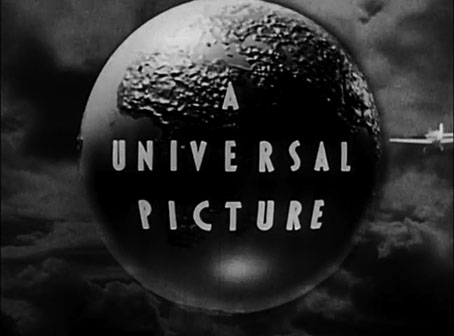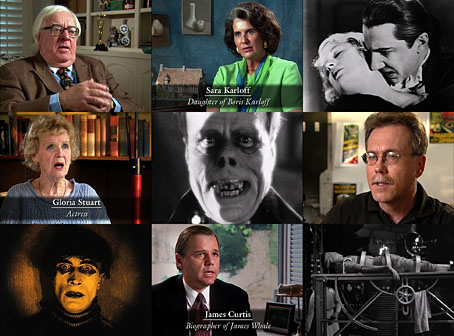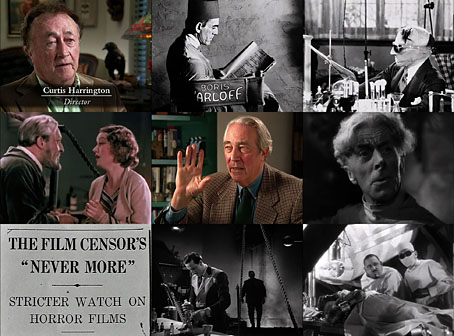A couple of Halloweens ago I worked my way through a blu-ray box of the horror films made by Universal Studios in the 1930s and 40s. It was a fun and instructive experience: fun because I’d not watched many of the films properly for a long time; instructive for reaffirming my dislike of Tod Browning’s Dracula, a film so inert and lacking in cinematic drama it may as well be a series of still pictures. Browning’s film is further diminished when you have the opportunity to watch James Whale’s Frankenstein films immediately after it. The collection also allowed me to compare the BFI release of Universal’s silent version of The Phantom of the Opera, where Lon Chaney is an unforgettable Phantom, with the 1943 remake, a film I didn’t recall having seen before. The only positive things about the remake are the always worthwhile Claude Rains, even if he is wasted in the Phantom role, and seeing the massive Paris Opera House set from the silent version being reused.
The differences between the Universal adaptations of Dracula and Frankenstein are noted in Kevin Brownlow’s 90-minute documentary which is an extra on the Frankenstein disc. Brownlow’s film, which was originally made for TV in 1998, charts the evolution of Universal’s horror films from their roots in silent cinema and German Expressionism up to the 1940s when the cycle deteriorated into sequelitis and self-mockery via Abbott and Costello. “Universal” here may be taken as referring to all of Hollywood’s early horror films. Rather than waste time on the studio’s increasingly inferior sequels, rival productions from other studios are briefly discussed: Dr Jekyll and Mr Hyde (Paramount), The Island of Lost Souls (Paramount), King Kong (RKO), and Mystery of the Wax Museum (Warner Brothers). In doing this Universal Horror follows the template that Brownlow established with fellow film historian David Gill in 1980 when they produced Hollywood for Thames TV, a 13-part series about the birth of American cinema which I rate as the best documentary series about film ever made. (Gill died in 1997 so Universal Horror is dedicated to his memory.) Hollywood interviewed as many people as possible connected with the production of the first silent films, following the format of the landmark The World at War (1973) series which related the events of the Second World War in 26 hour-long episodes. The World at War was narrated by Laurence Olivier; for Hollywood Brownlow & Gill had James Mason, not only an equivalent voice of authority but also a man with a great enthusiasm for silent cinema. Subsequent Brownlow & Gill documentaries had Lindsay Anderson as narrator, another silents enthusiast with a similar gravitas in his narrative delivery. The narrator of Universal Horror, Kenneth Branagh, isn’t bad as such but whatever his qualities as an actor, his voice alone is a poor match for these heavyweights. He does at least seem to have controlled the sporadic squeaks which mar his delivery in an earlier Brownlow & Gill series, Cinema Europe: The Other Hollywood (1995).
Universal Horror and Cinema Europe both fall short when compared to Hollywood by being made too late. By the 1990s most of the men connected with the early years of European cinema had died, and so had many of the actors who made the Universal films. It’s left to a handful of survivors, most of whom are women, to remember the days of their youth: Nina Foch (The Return of the Vampire), Gloria Stuart (The Invisible Man), Fay Wray (who must have spent most of her later years repeating stories about King Kong but here also discusses her role in Mystery of the Wax Museum), Lupita Tovar (the Spanish-language Dracula), Turhan Bey (The Mummy’s Tomb), Rose Hobart (Dr Jekyll and Mr Hyde), and Curt Siodmak (The Wolf Man). Additional commentary is provided by the daughters of significant figures: Sara Karloff, Carla Laemmle (who has a cameo in Dracula) and Arianne Ulmer whose father, Edgar G. Ulmer, directed The Black Cat for Universal, a much better film than the 1943 Phantom of the Opera, and one which should have been in the box set instead. Lastly, there’s some outsider commentary by Ray Bradbury (who also appeared in Brownlow’s next documentary, Lon Chaney: A Thousand Faces), Gavin Lambert, James Karen, Forrest J. Ackerman, Curtis Harrington, James Curtis (author of James Whale: A New World of Gods and Monsters), and David J. Skal (author of Hollywood Gothic, The Monster Show, etc). Given the breadth of the subject—two decades of film history—this should have been a series like Cinema Europe, but horror on the page or on the screen remains the most abject of the genres, continually marginalised, complained about, ignored, censored, banned. Ninety minutes of documentary time is often as good as it gets, especially with Kevin Brownlow producing.
Universal Horror at the time of writing is available for viewing at the Internet Archive, waiting for Universal’s legal goons to put a stake through its heart. Someone has also uploaded the whole of Brownlow & Gill’s Hollywood series which is gratifying to see. The latter is scattered around YouTube in varying quality so it’s good to have a range of options. It’s essential viewing wherever you see it.
Previously on { feuilleton }
• Illustrating Dracula
• Illustrating Frankenstein
• Psychotronic Video
• Dracula and I by Christopher Lee
• Nightmare: The Birth of Horror
• Rex Ingram’s The Magician
• The Mask of Fu Manchu




Agree about Dracula (1931). Doesn’t hold up at all. Rather more interesting is the “sequel” Dracula’s Daughter from 1936. It suffers a bit from the same problems as the original but is worth it for Gloria Holden’s performance as the tortured Countess Zaleska. It’s always noted for its “implied” lesbianism but there doesn’t seem to have been anything implied about it at all. The producers, the Studio and the critics all seem to have been perfectly aware what was going on. The famous “seduction scene” between Holden and Nan May is pretty amazing for the 1930s.
Dracula’s Daughter is one of the better ones, in terms of atmosphere and memorable characters. Holdren as the tortured daughter is wonderfully smokey, more Anne Rice vamp than bloodlust monster.
If you haven’t, you need to see George Melford’s Spanish Dracula, filmed on the same stage as Browning was making his. Melford began directing the film shooting at night while Browning’s crew would shoot during the day. At certain times, both crews would shoot on the same set.
I know many horror hounds who feel the Spanish one captures a bit more flavor and fear, and I tend to agree.
I love Frankenstein, and recently watched
The Spirit of the Beehive at a private screening with two buddies, and fell in love with Frankie all over again.
Oftentimes, since I’m in Studio City, I’ll head down to Universal Studios CityWalk and see what new horror merch they’ve come up with at the monster store. I recently purchased an Invisible Man action figure…that is essentially an empty box…or is it?
Dracula’s Daughter does receive a mention in the documentary, as does its lesbian subtext. It’s the only sequel they give any attention to apart from Bride… and Son of Frankenstein. Also one I haven’t seen for a long time.
Jay: The Spanish Dracula is included on the blu-ray set I was watching, and I think it’s now a standard feature of the Universal reissues since its reputation has grown. I think David J. Skal may have helped with this, he gave the film a lengthy appraisal in Hollywood Gothic, comparing it favourably to the Browning version. Carlos Villarias is pretty hopeless in the title role but I agree that the film itself is much more lively and atmospheric.
Great post John, always a treat to reflect on the early Universal horror films. Not a Universal film but White Zombie from 1932 is one of the highlights of Lugosi’s career and unlike Dracula, it uses this new fangled sound thing with great verve… I sympathize with your opinion on Kenneth Brannagh’s dissatisfactory narrator, I recently watched on Sky Arts, a documentary about Steve McQueen’s abandoned racing car film, Day of the Champion – a very good, impressively comprehensive documentary that is all but ruined by David Letterman’s bland narration… Your mention of Brownlow and Gill’s Hollywood is timely as I recently finished Network’s 5-disc, 15-episode Story of Film DVD, Mark Cousins’ very personal but very good take on the history of Cinema, and it’s sent me back to the Silent films in my collection, plus I’m re-reading Brownlow’s superb 1968 book The Parade’s Gone By…
Hi Wes. Thumbs up for White Zombie, which I was tempted to mention along with a couple of other films as better vehicles for Lugosi’s acting. He’s very good as the hirsute Ygor in Son of Frankenstein but then he has more to do in that role, and more to say than Dracula does.
The Parade’s Gone By is the book about early American cinema. There was also a book that accompanied the Hollywood series that still turns up in secondhand shops. The series seems even miraculous now when the people on screen are talking about events that took place over a century ago. It’s like televisual time travel.
True, the only issue is Carlos, sadly.
Off topic a bit: I just finished I Walked With a Zombie and The Leopard Man tonight, and I’m reminded how much I enjoy a Val Lewton film.
There’s a scene in Zombie that chilled me. I recommend both if you haven’t seen them. Good character horror, albeit with that RKO budget. Shudder had all his films streaming, but I think they’re leaving soon.
I love the Val Lewton films! Would be good to see all of them again, there are many I haven’t seen for a very long time. I was thinking that if Brownlow’s documentary had been a series he could have done a whole episode about RKO, taking in the Lewton films, King Kong and its precursor, The Most Dangerous Game.
I’d be remiss if I didn’t mention two Unversal films that often get overlooked.
The Black Cat with Lugosi and Karloff, is one of my favorites. Two honeymooners find themselves captive in a mansion by a satanic priest who has chosen the woman to be Satan’s bride. The set design is stellar, with the hyperactive Bauhaus style mansion a character itself. And, I may be mistaken, but it might be the first American film to depict a Black Mass-with abstract cross shaped sacrificing altar added for good measure. Yay for that!
Murders in the Rue Morgue is another gem. A haunting atmospheric set, heavily influenced (more like copied) by the German Expressionist classic, The Cabinet Of Dr. Caligari. I believe it’s Lugosi in one of his most sinister roles. He plays a deranged scientist who searches Paris for a “prospective bride” for his pet gorilla. Inviting young ladies to his laboratory, he injects his victims with gorilla blood and then disposes of their ravaged bodies through a trapdoor. Some of the most gruesome scenes Universal ever made. Another interesting tidbit is the gay insinuation to Lagosi’s character who lives with another man.
Both of these (very) loosely based on Poe’s short stories.
(Ok enough from me ????????)
Both those films are featured in the documentary. It’s typical of a Brownlow production for him to point out that Karloff’s name in The Black Cat–Hjalmar Poelzig–is a reference to real architect and set designer Hans Poelzig, who created the sets for Paul Wegener’s third Golem film. I’ve read that Karloff’s sect was based (very loosely) on Aleister Crowley’s group of followers but still don’t know how accurate this is.
Fairly sure I’ve never seen Rue Morgue, the clips didn’t prompt any memories.
Well while we’re on he subject, just for the record, my absolute favorite of the Universal movies is The Mummy with good ole Boris Karloff. He was a much better actor than Lugosi and was much better served with his choice of roles over the years. It’s basically a rewrite of Dracula but with lots more pizzazz. (Makes me wonder what a Karloff led Dracula would have been like.)
The classic scene when the doomed archeologist raises Imhotep from his sleep by silently mouthing the text of the Book of the Dead is enough to fry the synapses of an impressionable young kid and make him a fan for life.
“He went for a little walk!!!”
Starring “Karloff the Uncanny”!
http://www.impawards.com/1932/mummy.html
The Mummy was one of the stand-out films in the collection I was watching. Karloff had an, er…uncanny ability to be creepy simply by standing and staring.